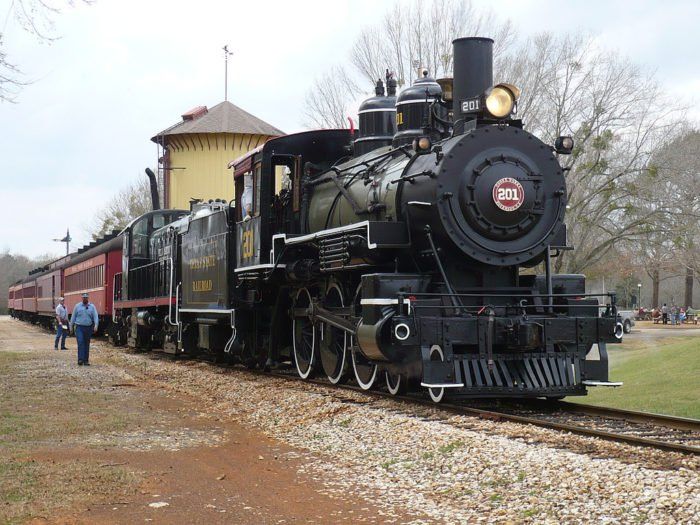Who doesn’t love a train? There are fans of Thomas the (talking) Tank Engine, admirers of the Hogwarts Express, model train lovers, and creative students of American history, who want to know what happened to the Golden Spike that completed the Transcontinental Railroad. (If you’ve got rosy visions of driving to Promontory Point and extracting it, forget it: it’s in the Smithsonian.)
See below for books and resources for all ages, including a great train robbery, adventurous orphans, a really cool model steam engine, and a railroad version of Moby Dick (with giant moles).
Table of Contents
TRAINS FOR BEGINNERS
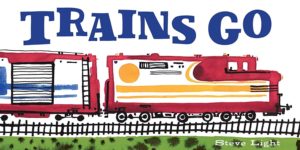 |
Steve Light’s Trains Go (Chronicle Books, 2012) is a masterpiece of onomatopoeia for toddlers, with great illustrations and lots of ZOOSHs, WHOOSHs, CLANGs, and TOOTs. For ages 2-5. |
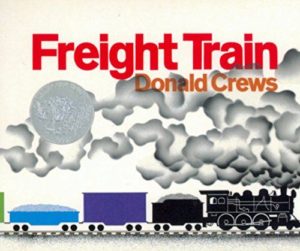 |
Donald Crews’s Freight Train (Greenwillow, 2004) is a gorgeous and colorful introduction to the parts of a train: black steam engine, purple box car, green cattle car, orange tank car, red caboose. For ages 2-6. |
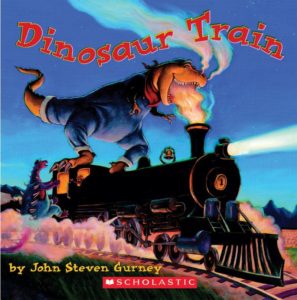
|
Dinosaurs! And trains! In John Steven Gurney’s Dinosaur Train (HarperCollins, 2002), a little boy whose favorite things are dinosaurs and trains draws a dinosaur-and-train picture before going to bed and heads off on an imaginative train adventure, packed with colorful dinosaurs, among them a T. rex engineer in overalls. For ages 3-5. |
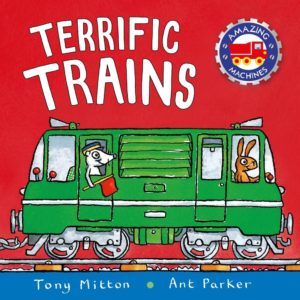 |
In Tony Mitton’s adorable Terrific Trains (Kingfisher, 2000), pop-eyed animal characters head off on a rhyming train journey (“Starting from the station with a whistle and a hiss/steam trains huffing and puffing like this”). For ages 3-6. |
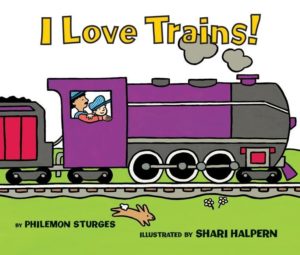
|
In Philemon Sturges’s I Love Trains (HarperCollins, 2003), a little boy in a stripey engineer’s cap and overalls watches a train go by, while telling – in rhyme – all about it, from engine, hopper, boxcar, and flatcar to caboose. For ages 3-6. |
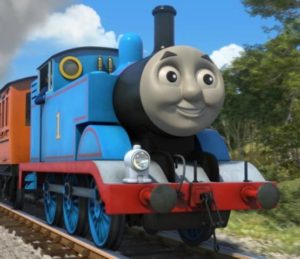
|
Thomas the Tank Engine (Random House Books for Young Readers, 2005) was first featured in the Railway Series books by Wilbert Awdry in the 1940s – and, like Winnie the Pooh, Thomas was based on a child’s (real) toy. Now Thomas is the star of countless books, games, apps, and a TV series. For ages 3-7. |
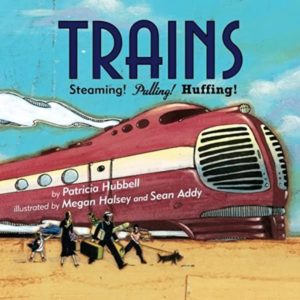
|
Patricia Hubbell’s Trains (Two Lions, 2009) – subtitled “Steaming! Pulling! Huffing!” – is a rhyming introduction to all things train, with clever collage-style illustrations and a lot of creative typefaces. For ages 3-7. |
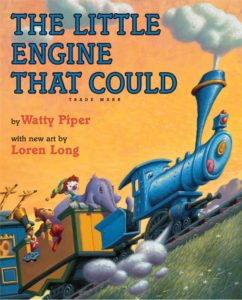
|
Watty Piper’s classic The Little Engine That Could (Platt & Munk, 1930) is now available in any number of editions, but all star the determined little blue train who finally (“I think I can; I think I can…”) makes it over the mountain with a load of toys. It’s supposed to instill the virtues of courage and persistence in the very small; parents can quote bits of it comfortingly to frustrated five-year-olds, who have thrown a failed project on the floor and are stamping upon it. |
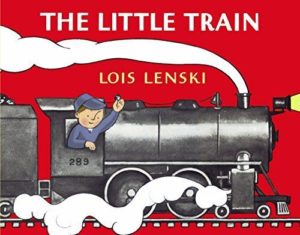
|
In Lois Lenski’s The Little Train (Random House, 2000), Engineer Small drives his train from Tinytown to Union Station in the big city, with lots of explanations for young train fans along the way. For ages 4-7. |
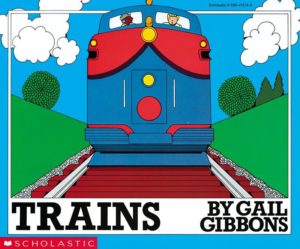
|
By Gail Gibbons, Trains (Holiday House, 1988) is a simple non-fiction introduction to trains with appealing bright-colored illustrations, variously covering all things train, including steam, diesel, and electric engines, boxcars, tank cars, passenger cars, refrigerator cars, and the ever-popular caboose. For ages 4-7. |
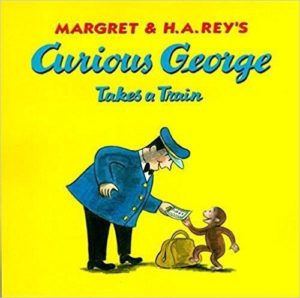
|
In Margaret and H.A. Rey’s Curious George Takes a Train (Houghton Mifflin, 2002), everybody’s favorite little monkey heads for the busy train station along with the Man in the Yellow Hat – and inevitably gets in a lot of trouble. For ages 4-8. |
| At Curious George’s website, George’s Busy Day:Train Station is an interactive train-based math game for early-elementary students. | |
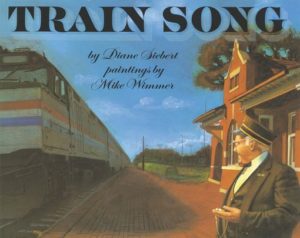
|
Diane Siebert’s Train Song (HarperCollins, 1993), illustrated with gorgeous glowing paintings by Michael , is a rhythmic poem that captures the clickety-clack essence of train travel: “locomotives/cars in tow/going places/Buffalo/New York City/Boston, Mass./slowing ‘neath the underpass.” For ages 4-8. |
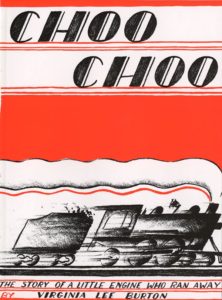
|
Virginia Lee Burton’s Choo Choo (Sandpiper, 1988), illustrated in dramatic black, white, and red, is the story of a rebellious little engine who runs away, having decided that she can go much faster without any troublesome passengers. She gets into all kinds of trouble before learning a useful lesson. For ages 4-8. |
| On YouTube, Choo Choo is a reading of the story by Peter Bradley, with illustrations from the book. | |
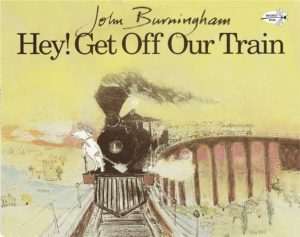
|
John Burningham’s award-winning Hey! Get Off Our Train (Dragonfly Books, 1994) is an unlikely mix of train trip and endangered animals – but it works. A little boy and his stuffed dog embark on a magical nighttime train trip, collecting animals along the way. Each is initially greeted with cries of “Hey! Get off our train!” until the animal explains its plight: someone is trying to cut off the elephant’s tusks; the polar bear is being hunted for fur; the tiger’s forest is being cut down. For ages 4-9. |
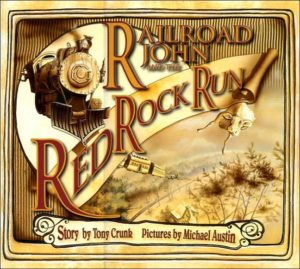
|
In Tony Crunk’s Railroad John and the Red Rock Run (Peachtree Publishing, 2006), Railroad John – who hasn’t been late in 40 years – is racing the Sagebrush Flyer to Red Rock for Lonesome Bob’s wedding to Wildcat Annie (who waits for no one). Inevitably, the train is held up by outlaws, a flood, and a cyclone, but still manages to make it on time. (Wildcat Annie, on the other hand, is late.) For ages 5-8. |
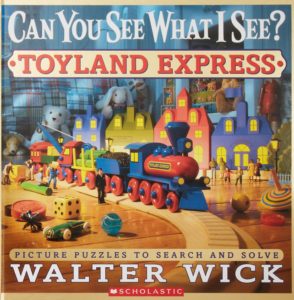
|
Photographer Walter Wick’s Can You See What I See? Toyland Express (Cartwheel Books, 2011) is a fascinating picture-puzzle book that begins in a toymaker’s workshop, where a wooden train is being assembled and painted; then moves to a toy shop window, where the finished train is displayed along with dozens of other toys; and next to a birthday party. In each wonderful image-crammed spread there is a list of 20 things for readers to find: “Can you see what I see? 2 bells, a birdhouse/a pencil, a pail/a ball of string/a long cat tail…” Fun for ages 5 and up. |
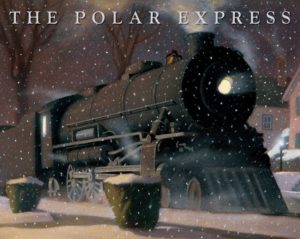
|
Chris Van Allsburg’s Christmas-themed The Polar Express (Houghton Mifflin, 2009), in which a wonderful train transports the narrator to the North Pole, is now a classic – with a final theme of unshakeable belief. For all ages. |
| The computer-animated movie version of The Polar Express (Warner Brothers, 2004), directed by Robert Zemeckis, is rated PG. The book is better. | |
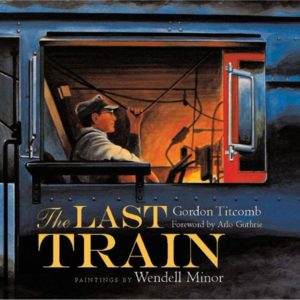
|
Folk musician Gordon M. Titcomb’s The Last Train (Roaring Brooks Press, 2010), with stunning illustrations by Wendell Minor, is an evocative celebration of the great age of the railroads, as a boy recalls the experiences of his father and grandfather, both railroad men. (“My Granddad was a railroad man, he drove the trains around/My Daddy, he sold tickets till they closed the station down/Now the tracks that shone like silver have turned to rusty brown/Thirty years ago the last train rolled through town.”) Wonderful for all ages. |
